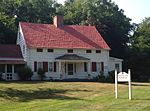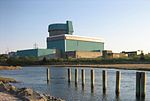Wardenclyffe Tower (1901–1917), also known as the Tesla Tower, was an early experimental wireless transmission station designed and built by Nikola Tesla on Long Island in 1901–1902, located in the village of Shoreham, New York. Tesla intended to transmit messages, telephony, and even facsimile images across the Atlantic Ocean to England and to ships at sea based on his theories of using the Earth to conduct the signals. His decision to increase the scale of the facility and implement his ideas of wireless power transmission to better compete with Guglielmo Marconi's radio-based telegraph system was met with refusal to fund the changes by the project's primary backer, financier J. P. Morgan. Additional investment could not be found, and the project was abandoned in 1906, never to become operational.
In an attempt to satisfy Tesla's debts, the tower was demolished for scrap in 1917 and the property taken in foreclosure in 1922. For 50 years, Wardenclyffe was a processing facility producing photography supplies. Many buildings were added to the site and the land it occupies has been trimmed down from 200 acres (81 ha) to 16 acres (6.5 ha) but the original, 94 by 94 ft (29 by 29 m), brick building designed by Stanford White remains standing to this day.
In the 1980s and 2000s, hazardous waste from the photographic era was cleaned up, and the site was sold and cleared for new development. A grassroots campaign to save the site succeeded in purchasing the property in 2013, with plans to build a future museum dedicated to Nikola Tesla. In 2018 the property was listed on the National Register of Historic Places.








